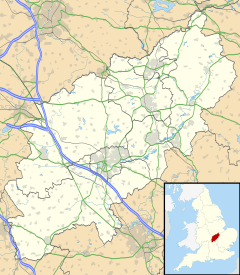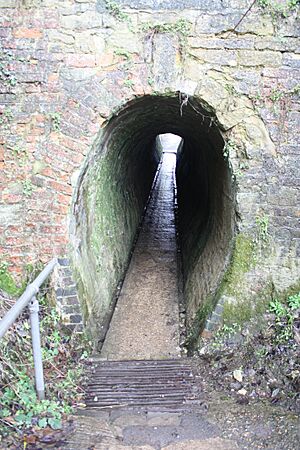Cosgrove, Northamptonshire facts for kids
Quick facts for kids Cosgrove |
|
|---|---|
 Church of SS Peter and Paul, Cosgrove |
|
| Population | 480 (2001 Census) 521 (2011 Census) |
| OS grid reference | SP790426 |
| • London | 62 miles (100 km) |
| District |
|
| Shire county | |
| Region | |
| Country | England |
| Sovereign state | United Kingdom |
| Post town | MILTON KEYNES |
| Postcode district | MK19 |
| Dialling code | 01908 |
| Police | Northamptonshire |
| Fire | Northamptonshire |
| Ambulance | East Midlands |
| EU Parliament | East Midlands |
| UK Parliament |
|
Cosgrove is a village in Northamptonshire, England. It's located about 2 miles (3.2 km) north of Stony Stratford and 6 miles (9.7 km) north of Central Milton Keynes. The village is also about 12 miles (19.3 km) south of Northampton along the A508 road.
The River Tove flows to the east of Cosgrove. It then joins the River Great Ouse just south of the village. The River Great Ouse forms the border with the City of Milton Keynes in Buckinghamshire. The famous Grand Union Canal also passes right through the middle of Cosgrove.
The name 'Cosgrove' probably means 'Cof's grove'. A grove is a small group of trees.
Contents
Grand Union Canal History
The Grand Union Canal has played a big part in Cosgrove's history. Just south-east of the village, the canal crosses the valley of the River Great Ouse. It does this using a special bridge called the Cosgrove Iron Trunk Aqueduct.
When the canal was first built, boats had to go down and up nine temporary locks to cross the river. This was slow and wasted a lot of water. Builders always planned to use an aqueduct instead. A brick aqueduct was built, but it fell down in 1808. So, the temporary locks were used again.
The current Cosgrove aqueduct was then built. It's made of strong cast iron and opened on January 22, 1811. You can still see the old lock gates next to the footpath below the canal.
Buckingham Canal Branch
A branch of the canal, called the Buckingham branch or Buckingham Arm, opened in 1801. It was about 10.5 miles (17 km) long and started just south-east of Cosgrove village. This branch closed in the 1960s. However, people are now working to reopen it. The Buckingham Canal Society was formed to help bring this old canal back to life.
The Ice House
The Buckingham branch of the canal used to freeze solid in winter. People from all around would come to skate on it. Around 1820, the owner of Cosgrove Hall built an ice house. It was halfway between the canal and the Hall.
The ice house looked a bit like a stone windmill, but most of it was underground. Every winter, from 1820 until the early 1900s, ice cut from the canal was stored inside. It was packed with straw to keep it frozen. This ice was then sold to local fishmongers and butchers. This was how they kept food cold before refrigerators existed! The ice house is now old and unused, but it was one of the last remaining ones in England.
Cosgrove's Trading Past
For about 200 years, life in Cosgrove was shaped by the canal and later by the railway. The village was once a very busy trading center. You can still see old iron tracks at the canal wharf. But with modern roads and transport, the village has become quieter. The traders have left, and Cosgrove is now a peaceful, rural village again.
Solomon's Bridge
There's a beautiful gothic-style bridge over the canal called Solomon's Bridge. It was built in the 1790s. A local landowner, the Biggins family, insisted on it. It's one of only two ornamental bridges on the canal.
Other Interesting Places in Cosgrove
Parish Church
The main church in Cosgrove is called St Peter and St Paul. Parts of it were built in the 13th century, which means it's over 700 years old! The tower is more than 70 feet tall. It has six bells, and one bell named 'Santa Maria' dates back to the 15th century.
Cosgrove Hall
Cosgrove Hall is a large country house. It was built in the early 1700s where an older house once stood. It is a private home and not open to the public. The building was badly damaged by a fire in October 2016.
The Priory
The Priory was built in the 1600s by the Rigby family. It was first known as the Manor House. Its name changed to The Priory around 1810. It is now a privately owned home.
St. Vincent's Well
Behind the old National School on High Street, you'll find St. Vincent's Well. It's surrounded by iron railings. People say the water from this well has a lot of iron. Some believe this gives the water special healing qualities.
Roman Villa Site
South-east of Cosgrove Hall and the church, near the canal, is the site of a Roman Villa. A bath house and temple were also found here. These were discovered in 1957 and dug up in the 1950s and 60s. Many interesting items, including a pot of silver coins, were found when the canal was being built. This site is about 1 mile from the old Roman Road called Watling Street.
The Quarries
South-west of the village are The Quarries. These are the remains of a medieval (Middle Ages) limestone quarry. Today, it's a special type of grassland called calcareous grassland. It has many unique plants that love limestone, like the spotted cat's ear and fragrant orchid. Rare insects, such as the ground beetle, also live here. You might also spot birds like the skylark and barn owl.
Cosgrove Leisure Park
Cosgrove Leisure Park is a popular spot for visitors and holiday-makers. The park is built on an area of old gravel pits that are now filled with water. It's located near the River Great Ouse, south of the village.
The park has a swimming pool, paddling pool, and lakes for fishing. You can also enjoy water sports like water-skiing and jet-skiing. There are spaces for 500 touring caravans and 460 holiday homes that people own.
Images for kids
See also
 In Spanish: Cosgrove para niños
In Spanish: Cosgrove para niños



